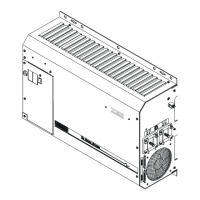OPERATION
Page
68
Copyright Trace Engineering Company, Inc.
5916 - 195th Street N.E.
Arlington, WA 98223
Telephone: 360/435-8826
Fax: 360/435-2229
www.traceengineering.com
PS Series Inverter/Charger
Part No. 3597
Rev. D: November 23, 1999
INVERTER/CHARGER MODE
IN BRIEF
The PS Series is capable of automatically transferring AC loads from the inverter to a utility grid or
generator. The inverter/charger can transfer upon the availability of AC power (FLT mode - the default)
either at a specific time each day (using the GRID USAGE TIMER (18) menu heading), or upon a low
battery condition (LBX mode).
TRANSFERRING UPON AVAILABILITY OF AC POWER
When AC power is supplied to the AC HOT INPUT, the inverter will automatically transfer from inverter
mode to battery charger mode. Before transferring, the inverter will check to see if the AC input voltage
and frequency are within tolerance. If AC voltage is acceptable, the inverter synchronizes and connects to
the inverter’s AC output without interruption of power. Once transferred, the inverter/charger can recharge
the battery.
The FLT (float) mode is the default mode in the GRID USAGE menu item under the INVERTER SETUP
(9) menu heading and is the proper mode for use with a back-up generator that is being manually or
automatically started and for most utility connected applications.
The SLT (silent) mode (requires the SWRC to select) is used only if the source of AC power is the utility
grid and the ‘MAXIMUM AC AMP IN’ switch is in the AC1 position. In this mode, the only operational
difference is that the battery charger will only be engaged for a single period of time each day, set by the
BULK CHARGE TRIGGER TIMER (15) menu heading setting. This reduces the power consumption of
the inverter over the period of a day. It is also used in applications where the slight noise of the inverter
might be undesirable, such as at night. AC power continues to be passed through the inverter’s transfer
relay while the charger is not engaged. If the AC source fails, the inverter will turn on automatically and
power the connected AC loads. When utility power returns, the AC loads will be reconnected to the utility
and the battery charger will complete a bulk charge cycle if required. Once this has been completed the
battery charger will turn off, but the loads will remain connected to the utility.
TRANSFERRING BASED ON BATTERY VOLTAGE
If LBX (low battery transfer) is selected in the SET GRID USAGE menu item under the INVERTER
SETUP (9) menu heading, the decision to transfer to and from utility power will be based upon the battery
voltage. With LBX enabled (by the SWRC), the SET LOW BATTERY CUT IN VDC setting and the SET
LOW BATTERY TRANSFER VDC setting determine the DC transfer voltages. When the battery voltage
reaches the SET LOW BATTERY TRANSFER VDC setting for more then 20 seconds, the AC loads are
transferred from the inverter to the utility. At the LOW BATTERY CUT IN voltage, the AC loads are
transferred from utility to the inverter. The low battery transfer system includes a 20 second time delayed
so that large loads are less likely to cause a transfer to the utility grid during motor startup, etc.
While connected to the utility, the battery charger will not be engaged. This is to allow the alternate power
source (solar, wind or hydro) to recharge the battery instead of the utility power.
INVERTER/
CHARGER
UTILITY GRID
AC LOADS
AC
BATTERY
GENERATOR
AC
AC

